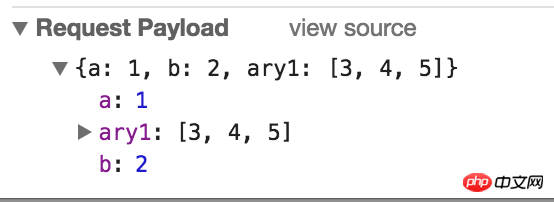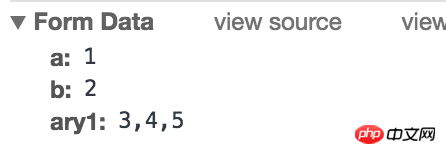Details on the use of Get/Post parameters in Jquery and AngularJS
Passing parameters is not difficult, but sometimes it can be troublesome when it involves, for example, passing an object or form to the backend. Here are some usage methods. Now let us take a look at this angularjs article
First of all, we will introduce several attributes that we often confuse when sending requests:
dataType: Expect the data format returned by the server
mimeType: Tell how to process the data format returned by the server, so that the browser will process it accordingly, for example, set the type to " Text/html", then the client will know that this is an HTML document, and I can just present it directly; if it is "Application/pdf", then the client will know that it needs to start the PDF reader plug-in. Present content.
contentType: refers to the data type you want to send. For example, "application/json;charset=utf-8" is a very common type, and "application/x-www-form-urlencoded; charset=UTF-8" is the default type.
In addition, compare the difference between Request Payload and Form:
Request Payload needs to set Content-Type: application/json
In the chrome developer tool you You will see that it is passing an Object/json, and notice that it also contains an array. If you submit the request through ajax, the browser will only display the content you submitted through the Payload body. The browser does not know where the data comes from. Where does it come from 
Form form needs to set Content-Type: application/x-www-form-urlencoded or Content-Type: multipart/form-data , what you see through the developer tool is like this. In this case, form-data is the Request payload. The browser knows what key corresponds to what value, so it is displayed in the form of xx=xx. It should be noted that the array is Converted into a string. 
Therefore, when the data you need to transfer is only key-value pairs, using Form is enough. If you need to transfer a complex structure (such as an embedded set of arrays, objects), it is more appropriate to use RequestPayload. (If you want to see more, go to the PHP Chinese website angularjs Learning Manual to learn)
Next, let us compare various parameter passing situations~
In one case, pass an ordinary string
JQuery:
let params = {
a: 1,
b: 2
}
// 第一种方法:
$.ajax({
"dataType": 'json',
"type": "GET",
"url": "your_request?" + $.param(params)
})
//第二种方法:
$.ajax({
"type": "GET",
"url": "your_request",
"data": params
})AngularJS:
var conf = {
method: 'GET',
url: 'your_request',
params: {
a: 1,
b: 2
}
};
$http(conf).then(function(response){
console.log(response.data);
}, function(){
console.log("error");
}).finally(function(){
console.log("finally");
});The second case: Post form data
JQuery :
let params = {
a: 1,
b: 2,
ary1: [3,4,5]
}
$.ajax({
"type": "POST",
"url": "your_request",
"data": params
})AngularJS:
Note that data needs to be converted into a URL-encoded string
ContentType needs to be set to 'application/x-www-form-urlencoded' to specify that the transmitted data format is Form
var conf = {
method: 'POST',
url: 'your_request',
data: $.param({
c: 3,
d: 4
}),
headers: {'Content-Type': 'application/x-www-form-urlencoded'}
};Third case: Use RequestPayload for Post parameters
JQuery:
Set contentType to "application/json" and serialize params
let params = {
a: 1,
b: 2,
ary1: [3,4,5]
}
$.ajax({
"type": "POST",
"url": "your_request",
"data": JSON.stringify(params),
"contentType": "application/json"
})AngularJS:
var conf = {
method: 'POST',
url: 'your_request',
data: {
c: 3,
d: 4
}
};Sometimes, when the response returned by the server is null, an xml parsing error will occur in Firefox. This is because Firefox uses xml to parse the server return value by default, and when a null return value is encountered, an xml parsing error occurs. A parsing error occurred.
It can be solved by setting mimeType in JQuery
$.ajax({
"dataType": 'json',
"type": "GET",
"url": "your_request",
"mimeType": "json"
})It is more difficult to set mimeType in AngularJS
This article ends here (if you want to see more, go here PHP Chinese websiteangularjs learning manual), if you have any questions, you can leave a message below
The above is the detailed content of Details on the use of Get/Post parameters in Jquery and AngularJS. For more information, please follow other related articles on the PHP Chinese website!

Hot AI Tools

Undresser.AI Undress
AI-powered app for creating realistic nude photos

AI Clothes Remover
Online AI tool for removing clothes from photos.

Undress AI Tool
Undress images for free

Clothoff.io
AI clothes remover

AI Hentai Generator
Generate AI Hentai for free.

Hot Article

Hot Tools

Notepad++7.3.1
Easy-to-use and free code editor

SublimeText3 Chinese version
Chinese version, very easy to use

Zend Studio 13.0.1
Powerful PHP integrated development environment

Dreamweaver CS6
Visual web development tools

SublimeText3 Mac version
God-level code editing software (SublimeText3)

Hot Topics
 1377
1377
 52
52
 How to implement an online speech recognition system using WebSocket and JavaScript
Dec 17, 2023 pm 02:54 PM
How to implement an online speech recognition system using WebSocket and JavaScript
Dec 17, 2023 pm 02:54 PM
How to use WebSocket and JavaScript to implement an online speech recognition system Introduction: With the continuous development of technology, speech recognition technology has become an important part of the field of artificial intelligence. The online speech recognition system based on WebSocket and JavaScript has the characteristics of low latency, real-time and cross-platform, and has become a widely used solution. This article will introduce how to use WebSocket and JavaScript to implement an online speech recognition system.
 WebSocket and JavaScript: key technologies for implementing real-time monitoring systems
Dec 17, 2023 pm 05:30 PM
WebSocket and JavaScript: key technologies for implementing real-time monitoring systems
Dec 17, 2023 pm 05:30 PM
WebSocket and JavaScript: Key technologies for realizing real-time monitoring systems Introduction: With the rapid development of Internet technology, real-time monitoring systems have been widely used in various fields. One of the key technologies to achieve real-time monitoring is the combination of WebSocket and JavaScript. This article will introduce the application of WebSocket and JavaScript in real-time monitoring systems, give code examples, and explain their implementation principles in detail. 1. WebSocket technology
 How to use JavaScript and WebSocket to implement a real-time online ordering system
Dec 17, 2023 pm 12:09 PM
How to use JavaScript and WebSocket to implement a real-time online ordering system
Dec 17, 2023 pm 12:09 PM
Introduction to how to use JavaScript and WebSocket to implement a real-time online ordering system: With the popularity of the Internet and the advancement of technology, more and more restaurants have begun to provide online ordering services. In order to implement a real-time online ordering system, we can use JavaScript and WebSocket technology. WebSocket is a full-duplex communication protocol based on the TCP protocol, which can realize real-time two-way communication between the client and the server. In the real-time online ordering system, when the user selects dishes and places an order
 How to implement an online reservation system using WebSocket and JavaScript
Dec 17, 2023 am 09:39 AM
How to implement an online reservation system using WebSocket and JavaScript
Dec 17, 2023 am 09:39 AM
How to use WebSocket and JavaScript to implement an online reservation system. In today's digital era, more and more businesses and services need to provide online reservation functions. It is crucial to implement an efficient and real-time online reservation system. This article will introduce how to use WebSocket and JavaScript to implement an online reservation system, and provide specific code examples. 1. What is WebSocket? WebSocket is a full-duplex method on a single TCP connection.
 JavaScript and WebSocket: Building an efficient real-time weather forecasting system
Dec 17, 2023 pm 05:13 PM
JavaScript and WebSocket: Building an efficient real-time weather forecasting system
Dec 17, 2023 pm 05:13 PM
JavaScript and WebSocket: Building an efficient real-time weather forecast system Introduction: Today, the accuracy of weather forecasts is of great significance to daily life and decision-making. As technology develops, we can provide more accurate and reliable weather forecasts by obtaining weather data in real time. In this article, we will learn how to use JavaScript and WebSocket technology to build an efficient real-time weather forecast system. This article will demonstrate the implementation process through specific code examples. We
 How to use insertBefore in javascript
Nov 24, 2023 am 11:56 AM
How to use insertBefore in javascript
Nov 24, 2023 am 11:56 AM
Usage: In JavaScript, the insertBefore() method is used to insert a new node in the DOM tree. This method requires two parameters: the new node to be inserted and the reference node (that is, the node where the new node will be inserted).
 Simple JavaScript Tutorial: How to Get HTTP Status Code
Jan 05, 2024 pm 06:08 PM
Simple JavaScript Tutorial: How to Get HTTP Status Code
Jan 05, 2024 pm 06:08 PM
JavaScript tutorial: How to get HTTP status code, specific code examples are required. Preface: In web development, data interaction with the server is often involved. When communicating with the server, we often need to obtain the returned HTTP status code to determine whether the operation is successful, and perform corresponding processing based on different status codes. This article will teach you how to use JavaScript to obtain HTTP status codes and provide some practical code examples. Using XMLHttpRequest
 How to get HTTP status code in JavaScript the easy way
Jan 05, 2024 pm 01:37 PM
How to get HTTP status code in JavaScript the easy way
Jan 05, 2024 pm 01:37 PM
Introduction to the method of obtaining HTTP status code in JavaScript: In front-end development, we often need to deal with the interaction with the back-end interface, and HTTP status code is a very important part of it. Understanding and obtaining HTTP status codes helps us better handle the data returned by the interface. This article will introduce how to use JavaScript to obtain HTTP status codes and provide specific code examples. 1. What is HTTP status code? HTTP status code means that when the browser initiates a request to the server, the service




